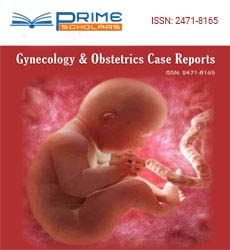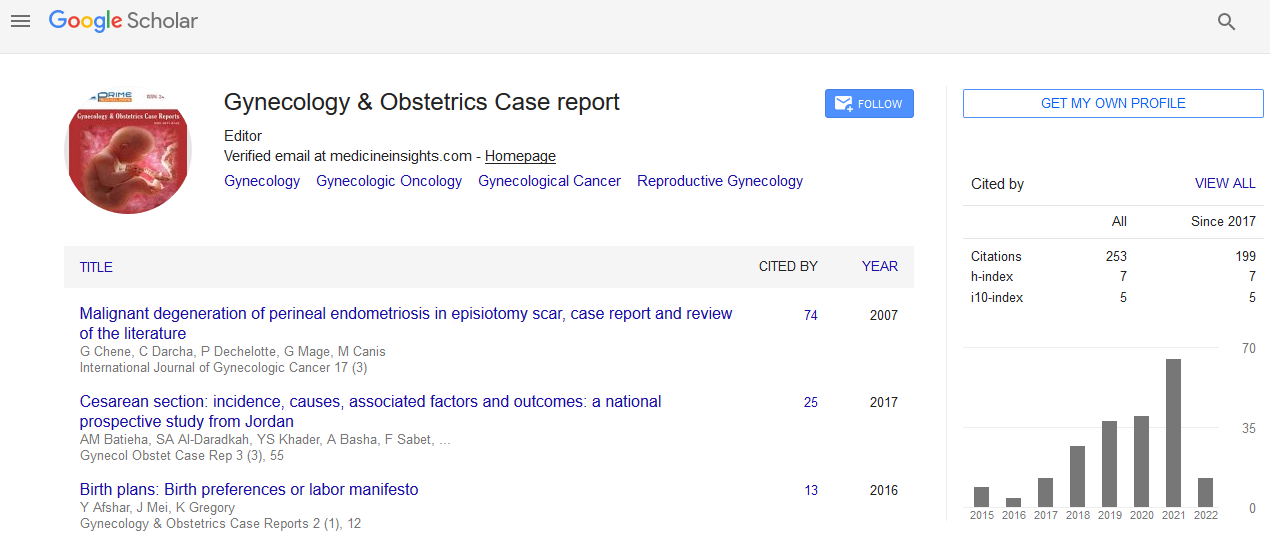Commentary - (2025) Volume 11, Issue 1
Preterm Birth: Risk Factors and Fetal Outcomes
Elin Leandro*
Department of Obstetrics and Gynecology, Medical University of Vienna, 10244 Wien, Austria
*Correspondence:
Elin Leandro, Department of Obstetrics and Gynecology, Medical University of Vienna, 10244 Wien,
Austria,
Email:
Received: 27-Dec-2024, Manuscript No. ipgocr-25-22697;
Editor assigned: 30-Dec-2024, Pre QC No. ipgocr-25-22697(PQ);
Reviewed: 10-Jan-2025, QC No. ipgocr-25-22697(Q);
Revised: 17-Jan-2025, Manuscript No. ipgocr-25-22697(R);
Published:
24-Jan-2025
INTRODUCTION
Preterm birth, defined as the delivery of an infant before 37 weeks of gestation, is a significant global health concern due to its association with a wide range of complications for both the mother and the infant. It is a leading cause of neonatal morbidity and mortality, as preterm infants are at higher risk of developing respiratory distress syndrome, infections, neurodevelopmental disorders and other long-term health challenges. Understanding the risk factors associated with preterm birth and the potential outcomes for the fetus are crucial for improving prevention strategies and neonatal care [1]. The risk factors for preterm birth are multifactorial and can be categorized into maternal, fetal and environmental factors. Maternal factors include age, previous preterm birth, chronic conditions such as diabetes or hypertension and lifestyle choices such as smoking and substance use. Women under the age of 18 or over 35 are at an increased risk of preterm birth due to hormonal imbalances, uterine abnormalities and other factors.
A history of a previous preterm birth significantly raises the risk for subsequent preterm deliveries, often due to underlying uterine or cervical issues that may predispose the pregnancy to early labor [2]. Chronic health conditions like diabetes and hypertension can also complicate pregnancy and increase the likelihood of preterm birth. Diabetes, whether gestational or pre-existing, can lead to problems such as poor placental function, fetal growth restriction and an increased risk of infections. Hypertension, particularly preeclampsia, can result in placental insufficiency, which in turn may trigger preterm labor. In addition, lifestyle factors such as smoking, excessive alcohol consumption and illicit drug use are strongly linked to preterm birth, as these substances can disrupt placental blood flow, increase the risk of infections and impair fetal development.
DESCRIPTION
Fetal factors also play a role in preterm birth. Multiple pregnancies, such as twins or triplets, are more likely to be delivered prematurely due to the increased strain on the motherâ??s body and the limited space in the uterus. Infections, particularly those affecting the genital tract, have been shown to trigger early labor, as the body responds to the infection by initiating inflammatory processes that can lead to premature rupture of membranes or cervical dilation. Certain fetal anomalies, such as congenital heart defects or structural abnormalities of the urinary tract, can also lead to preterm birth due to complications arising during the pregnancy [3]. Environmental factors, including socio-economic status, access to healthcare and maternal stress, are also contributing factors to preterm birth. Women living in lower socio-economic conditions often face barriers to proper prenatal care, which can delay the diagnosis and management of risk factors that contribute to preterm birth. Chronic stress, whether related to work, personal life, or socio-economic struggles, can also increase the likelihood of preterm birth, potentially by triggering inflammatory responses or affecting hormonal balance. The outcomes for the fetus born preterm are often dependent on the gestational age at birth. Infants born before 28 weeks of gestation are considered extremely preterm and face the highest risks of death and severe complications, including intracranial hemorrhage, severe respiratory distress syndrome and infections. These infants require intensive neonatal care, including mechanical ventilation, surfactant therapy and careful monitoring for signs of infection or organ dysfunction [4]. For infants born between 28 and 32 weeks, the risk of complications remains significant, but survival rates improve as the infant matures. Respiratory issues, such as transient tachypnea of the newborn or respiratory distress syndrome, are common in this group, but with modern neonatal care, these infants often recover and go on to lead healthy lives, though they may face some developmental challenges. These challenges can include delays in motor skills, speech and cognitive development, although many of these issues improve over time with proper early intervention and follow-up care. Infants born between 32 and 37 weeks are considered late preterm and have a higher risk of feeding difficulties, jaundice and temperature regulation problems. While the survival rate for these infants is very high, they may still face some short-term health concerns, especially if born before 34 weeks. These infants may also experience longer hospital stays compared to full-term infants and may be more likely to require assistance with breathing, feeding, or thermoregulation.
In the long term, preterm birth can have lasting effects on the childâ??s health and development. Premature infants are at higher risk for developmental delays, including cognitive deficits, speech delays and learning disabilities. They may also face long-term health problems, such as asthma, vision or hearing impairments and increased susceptibility to infections. These outcomes depend on a range of factors, including the infantâ??s gestational age at birth, the presence of any complications during delivery or the neonatal period and the quality of medical care received after birth. While much progress has been made in the care of preterm infants, the prevention of preterm birth remains a major challenge. Strategies for reducing preterm birth rates focus on addressing modifiable risk factors such as improving maternal health, reducing smoking and alcohol consumption and ensuring that women have access to early and regular prenatal care. The development of more effective interventions to prevent preterm labor, including the use of progesterone, cervical cerclage and other treatments, has shown promise, but further research is needed to fully understand the underlying causes of preterm birth and develop more targeted therapies [5].
CONCLUSION
Preterm birth is a complex and multifactorial condition with significant implications for both maternal and fetal health. Identifying and managing the various risk factors associated with preterm birth is key to reducing its incidence and improving outcomes for both mothers and infants. While neonatal care has advanced significantly, many preterm infants continue to face long-term challenges, highlighting the need for continued research and improved preventive strategies. Through better understanding and proactive management, the incidence of preterm birth can be reduced and the outcomes for those born prematurely can continue to improve.
Conflict of Interest
None.
Acknowledgment
None.
REFERENCES
- Silva TV, Bento SF, Katz L, Pacagnella RC (2021) Preterm birth risk, me?” Women risk perception about premature delivery–a qualitative analysis. BMC Pregnancy Childbirth 21: 1-7.
Google Scholar Cross Ref Indexed at
- Goto M, Miura SI, Yamamoto T, Fukuda Y, Kuwano T, et al. (2016) Anticoagulant therapy in a pregnant woman with May-Thurner syndrome. Intern Med 55(1): 59-62.
Google Scholar Cross Ref Indexed at
- Mousa AY, AbuRahma AF (2013) May–Thurner syndrome: update and review. Ann Vasc Surg 27(7): 984-995.
Google Scholar Cross Ref Indexed at
- Obstetricians A. (2018) ACOG practice bulletin No. 196: thromboembolism in pregnancy. Obstet Gynecol 132 (1): e1-e17.
Google Scholar Cross Ref Indexed at
- Labropoulos N, Leon Jr LR (2005) Duplex evaluation of venous insufficiency." Semin Vasc Surg 18:5-9.
Google Scholar Cross Ref Indexed at
Citation: Leandro E. (2025) Preterm Birth: Risk Factors and Fetal Outcomes. Gynecol Obstet Case Rep. Vol.11 No.1:05.
Copyright: Copyright: © Leandro E. This is an open-access article distributed under the terms of the Creative Commons Attribution License, which permits unrestricted use, distribution and reproduction in any medium, provided the original author and source are credited.

